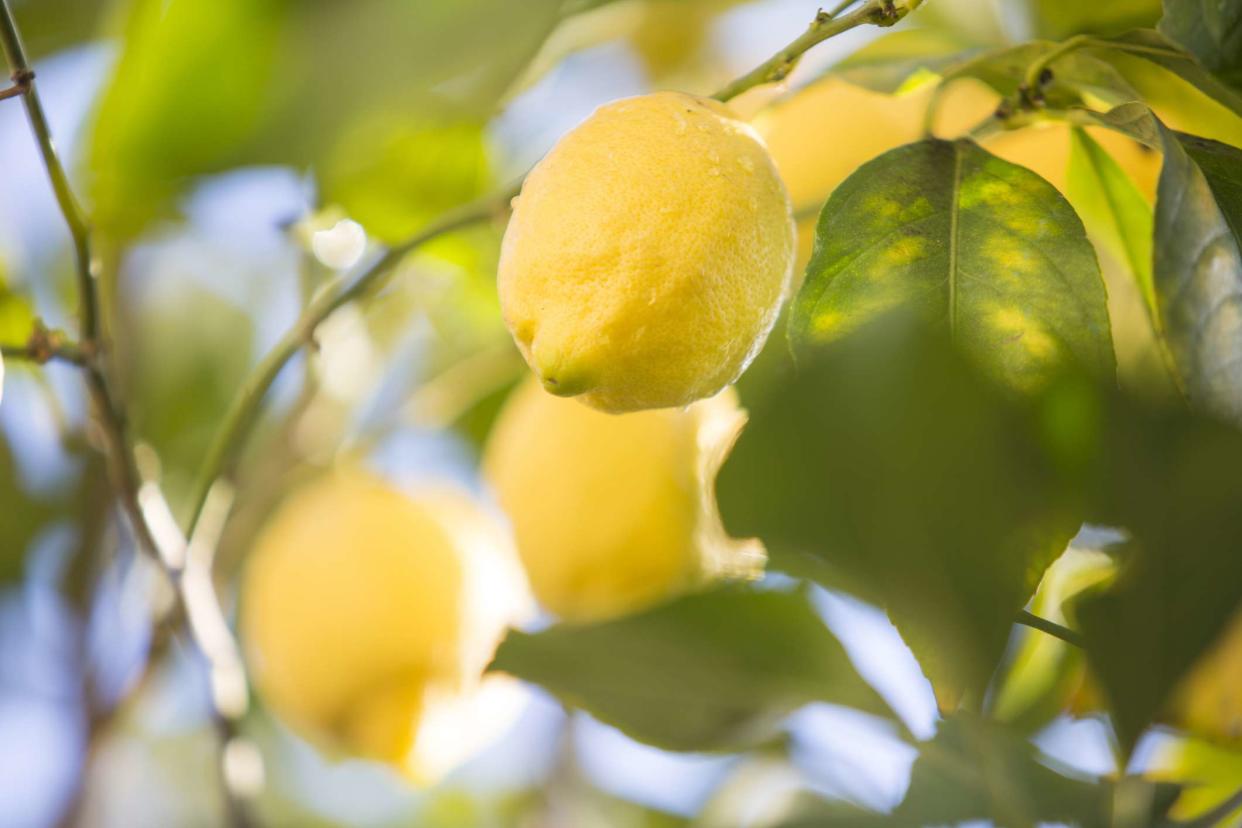Lemon Tree Leaves Turning Yellow? Here's How to Fix It

RUSS ROHDE / Getty Images
Lemon trees are one of the easier citrus trees to grow, but are not completely free of problems. An early sign trouble on lemon tree is yellowing leaves, a condition known as chlorosis which is a symptom of a plant disease that turns green tissue pale, yellow, or bleached. Establishing an adequate care routine for your lemon tree is the best defense against yellowing leaves, but if your lemon tree's leaves do turn yellow, here are the most common causes and how to fix them.
Overwatering
When leaves yellow and drop prematurely, overwatering may be the underlying cause. Identifying and quickly correcting this issue helps avoid root rot and plant loss. Lemon trees can become over saturated due to watering too often, incorrect planting medium, heavy clay soils, and inadequate drainage. Overwatering also dilutes and washes away nutrients.
Develop a good watering schedule, and water deeply but infrequently. Allow the top 2 to 3 inches of soil to dry out in between waterings. Use a citrus potting mix and a pot with plenty of drainage holes. Soggy potting medium can be discarded and the tree repotted in fresh, dry material.
For in-ground trees avoid low spots where water pools and amend clay soils with aged compost before planting. If your in-ground tree is too wet, allow it to dry out completely, then water less often.
Underwatering
Foliage that lacks moisture turns yellow, then brown and dry. Lemon trees can lose leaves if not adequately hydrated, but watering to excess is not the solution and can lead to more problems.
Give the plant a deep, thorough watering, letting excess drain. Dry soil can drain very quickly so wait several minutes and repeat. Check every day for moisture and continue to drench and drain until the soil holds moisture. Test with a moisture meter, or poke a finger in 2 to 3 inches. Once the plant is rehydrated and soil stays moist for several days to a week, resume watering more frequently as needed.
Watering Tip
Both overwatering and underwatering can cause leaves to yellow. Use a moisture meter to test soil or poke a finger in 2- to 3-inches to learn if your lemon tree is getting too much water or not enough.
Nutrient Deficiency
Lemon trees have specific nutrient needs and require sufficient nitrogen to make iron and other important micronutrients available. Nutrient deficiencies cause yellow spots and loss of color on foliage.
Lack of Nitrogen
When older leaves become chlorotic and loss of color spreads to new foliage, the tree lacks sufficient nitrogen. Nitrogen, phosphorous and potassium are the three primary nutrients citrus trees need to produce leaves, flowers and fruits.
Fertilize three times annually with a citrus fertilizer or one that has twice the amount of nitrogen as phosphorous and potassium—an NPK ratio of 2-1-1. Alternatively, feed your tree nitrogen-rich compost with worm castings or aged manure.
Lack of Iron
New leaves that emerge yellow or with yellow veins indicate iron deficiency. The problem spreads to older leaves and can turn them almost white when severe. The cause is lack of iron available in the soil, but it also can be due to overwatering.
Reduce frequency of watering if needed. Iron deficiency can also result from not enough nitrogen, so apply a citrus or nitrogen fertilizer that includes iron.
Lack of Zinc
When new leaves yellow and wrinkle, the tree is struggling from lack of zinc, which helps the plant make chlrophyll. Discoloration occurs between veins that remain green and necrotic spots appear along the center blade of the leaf. New shoots may be stunted and problems can advance to older foliage.
Spray leaves with a foliar kelp solution or add zinc oxide directly to soil.
Lack of Manganese
Manganese deficiency shows up as yellow spotting on leaves, starting with new growth and spreading to older foliage. Leaves often appear dry but, unlike with zinc deficiency, not stunted.
This condition often occurs in winter but improves on its own when spring growth begins. If the problem persists, treat soil with a granular manganese fertilizer or dilute in water and spray foliage.
Insufficient Light
When leaves yellow and drop prematurely your lemon tree may not be getting enough light. It needs close to 8 hours of direct sunlight daily.
If an immature outdoor lemon tree is not getting enough sunlight, it can be moved to a sunnier area. If you aren't able to relocate your tree, try removing or reducing other foliage shading the tree. Overwinter your potted lemon tree indoors directly in a south- or southwest-facing window to give it the best light.
Cold
Lemon trees thrive in tropical and subtropical environments. While mature outdoor lemon trees can withstand freezing temperatures for short periods, extended cold can damage leaves, causing them to turn yellow and drop. Newly planted and potted trees are more vulnerable to low temperatures.
Move your potted lemon tree indoors when night time temperatures remain steadily below 40 degrees F. Cover susceptible outdoor trees with frost cloth when extended cold temperatures are forecast. Water thoroughly beforehand to protect roots against frost damage.
Weeds
Lemon trees have shallow roots, so nutrient competition from weeds can cause the leaves of lemon trees planted in-ground to yellow.
Keep a 2- to 3-inch layer of mulch around the base of the tree, making sure it doesn't contact the trunk. Mulch improves moisture retention and discourages competing weeds.
Pests
Aphids, spider mites, and scale are sap-sucking insect pests that feed on leaves that yellow from moisture loss. This seldom results in the death of a plant, but infestations can cause significant damage.
Check the stems and undersides of leaves for pests. Aphids and spider mites can often be knocked off with a strong spray of water. Use neem oil or horticultural oil for scale and a mild soap solution for infestations of aphids and spider mites.

